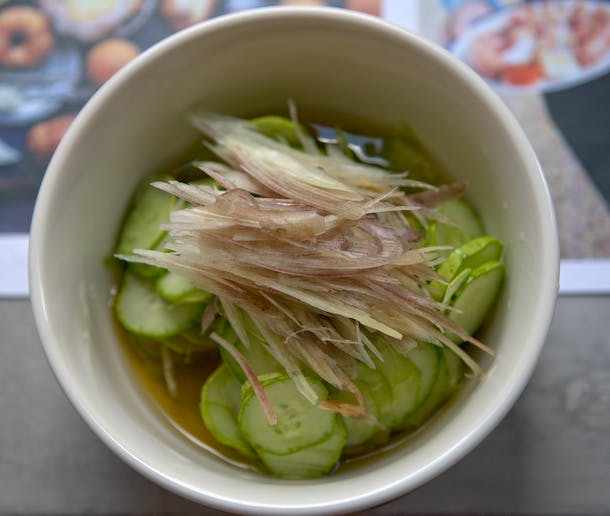
Dashi-infused Japanese Cucumbers
Learn how Atsushi demonstrated a fundamental notion of Japanese cooking with a simple dish of Japanese cucumbers soaked in konbu-katsuobushi dashi and garnished with myoga. Discover the reliance on dashi to express flavor and umami in Japanese cooking, and the cultural innovation driven by a millennium-long prohibition against eating meat in Japan.
At Saveur, Chef Atusshi Nakahigashi demonstrated a fundamental notion of Japanese cooking through this utterly simple dish, composed of Japanese cucumbers, a good konbu-katsuobushi dashi and myoga for garnish.
As the scholar Dr. Naomichi Ishige explains in "History and Culture of Japanese Food," his seminal book I've mentioned before in the Report (out of print, sadly), a fundamental difference between Japanese and Western cooking is that instead of the butter, olive oil and animal fats that form flavor in Western food, Japanese cooking relies on dashi to express flavor, and most importantly, umami. The reason for this was a millennia-long prohibition against eating meat in Japan, so the culture found another, ingenious, way to add complex flavor to ingredients.
To prepare this dish, Atsushi thinly sliced the cucumber and soaked it in chilled dashi (he suggests for three hours). To serve, he pulled the cucumber out of the dashi and garnished it with thinly sliced myoga, a deliciously fragrant bud that's a type of ginger. The dashi had transformed the Japanese cucumber, a variety less liquid than typical American cukes, into something much more interesting and savory -- umami, and Japanese food tradition, at work.
When you try this dish, I'd be grateful if you could let me know in the comments how it turns out. Did it work? Any questions or thoughts?
